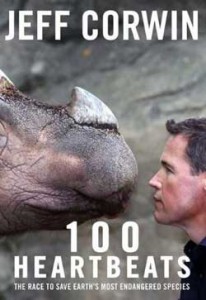On Jeff Corwin’s 100 HEARTBEATS

When I was asked if I wanted to read Jeff Corwin’s 100 HEARTBEATS (Rodale 2009) I was ambivalent. I know he’s a “conservationist,” therefore I know he will advocate for “managing” the “resources” that are sentient nonhumans. And managing means killing them, breeding them, and otherwise fiddling with their individuals in the hope of altering their populations. This is all very unveganly, but I went for it nevertheless.
Here’s the good news: This is a very readable explanation of how animals in the Hundred Heartbeat Club (there are 100 or fewer individuals in the wild today) got to be in the club. It’s a great primer on extinction and conservation for the layperson. It has entertaining stories, includes animals people care about because they like them (and also addresses that concept), and it describes how the numbers of various species decreased to the point of being classified as “endangered” or worse. In the majority of cases, it is humans who are to blame for the plunging numbers of animals, and Corwin is very clear about the extent to which we have destroyed the world around us.
The bad news is that Corwin writes that “every heartbeat matters” (xv) largely because “When we put the survival of the natural world in jeopardy, we simultaneously put our survival in jeopardy” (xv, and italics his). This is irksome, as the premise is that we need to save the animals (and which ones is an interesting discussion) because we will suffer if they are gone. And of course that premise is only possible because the animals (and everything else on the planet) are our “resources.” But again, he’s a conservationist, so none of this is a surprise. Also, after detailing how we’re responsible for much of this current, depressing state, there is no loud call for us to alter our behavior.
The animals featured include ones whose predicaments are due to:
- climate change (polar bears);
- poisoning (California condor-lead in shot that killed the individuals who became carrion, American bald eagle-DDT);
- human encroachment/loss of habitat due to our activities, such as logging, mining, drilling and deforestation (Florida panther, Iberian lynx, orangutan);
- pollution (anyone trying to survive in the Yangtze river in China);
- disease (native birds in Hawaii, Tasmanian devils);
- poaching (Bengal tiger);
- or a combination thereof.
It’s important to note that Corwin doesn’t think he has all of the answers. He does believe we have an obligation to intervene because we are responsible for the current plight of the rest of “the natural world,” which we evidently don’t belong to. But he constantly wonders where and when and how much we should intervene, which I suppose is laudable.
The part that I definitely believe is laudable, and I can get behind, is in the final chapter: “Exploited to Extinction.”
“What does the future hold for the members of the Hundred Heartbeat Club? That depends largely on us, our priorities, and our allocation of resources. Consider this: Every month, it takes $12 billion to fund America’s involvement in the Iraq War. For only $450,000, we could buy almost all of the habitat neded to protect Ecuador’s remaining frogs.
. . . .
Chances are that in any given community, there’s a river that needs to be cleaned up. Or an animal that could use the aid of human intervention, such as the Florida panther, which has benefited from the culverts built to help it safely cross highways (221).
. . . .
Consider all the steps it took to create our massive carbon footprint. Now we just need to step in a different direction. We can–and we must” (222).
Those are the final words of the book. What was not considered in the previous 221 pages is that we can indeed step in a different direction today. We can stop using animals and “allocate resources” to educate Homo sapiens worldwide to change their relationship to the animals around them. Corwin tells the story of the Maasai of Kenya, whose culture involved disdain for and slaughter of lions. Through a program of education “built on mutual respect and interest” (198), the Maasai have now become guardians and caretakers of the lions, whose numbers have increased since the program’s inception. In other words, we can change the way we think about animals. Cultural attitudes about animals can change.
In the perfect world, in a different book not written by a conservationist, the author would have left us with myriad ways we can decrease our carbon footprint and help the animals, beginning with ceasing our use of animals. But for now, we have a book that describes how we got here and what we might do . . . if we believe it’s our right to do what we want with the lives of other animals.



